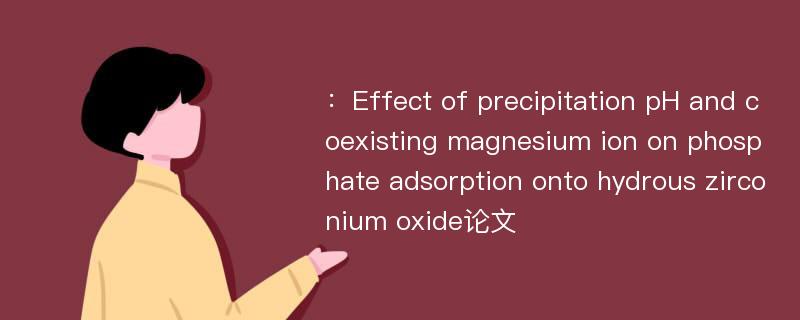
本文主要研究内容
作者(2019)在《Effect of precipitation pH and coexisting magnesium ion on phosphate adsorption onto hydrous zirconium oxide》一文中研究指出:To understand the effect of precipitation pH and coexisting Mg2+ on phosphate adsorption onto zirconium oxide(ZrO2), ZrO2 particles precipitated at pH 5.3, 7.1 and 10.5, i.e., ZrO2(5.3), ZrO2(7.1)and ZrO2(10.5), respectively were prepared and characterized, then their adsorption performance and mechanism in the absence and presence of Mg2+ were comparatively investigated in this study. The results showed that the Elovich, pseudo-second-order and Langmuir isotherm models correlated with the experimental data well. The adsorption mechanism involved the complexation between phosphate and zirconium. Coexisting Mg2+ slightly inhibited the adsorption of phosphate on ZrO2(5.3), including the adsorption capacity and rate, but coexisting Mg2+ greatly increased the adsorption capacity and rate for ZrO2(7.1)and ZrO2(10.5). The enhanced adsorption of phosphate on ZrO2(7.1) and ZrO2(10.5) in the presence of Mg2+ was mainly due to the formation of Mg2+-HPO42- ion pair(MgHPO40) in the solution and then the adsorption of MgHPO40 on the adsorbent surface, forming the phosphatebridged ternary complex Zr(OPO3H)Mg. In the absence of Mg2+ , the maximum phosphate adsorption capacity at pH 7 calculated from the Langmuir isotherm model decreased in the order of ZrO 2(7.1)(67.3 mg/g) > ZrO2(5.3)(53.6 mg/g) ≈ ZrO2(10.5)(53.1 mg/g), but it followed the order of Zr O2(7.1)(97.0 mg/g) > ZrO2(10.5)(79.7 mg/g) > ZrO2(5.3)(51.3 mg/g) in the presence of Mg2+ . The results of this work suggest that ZrO2(7.1) is more suitable for use as an adsorbent for the effective removal of phosphate from municipal wastewater than ZrO2(5.3) and ZrO2(10.5),because Mg2+ is generally present in this wastewater.
Abstract
To understand the effect of precipitation pH and coexisting Mg2+ on phosphate adsorption onto zirconium oxide(ZrO2), ZrO2 particles precipitated at pH 5.3, 7.1 and 10.5, i.e., ZrO2(5.3), ZrO2(7.1)and ZrO2(10.5), respectively were prepared and characterized, then their adsorption performance and mechanism in the absence and presence of Mg2+ were comparatively investigated in this study. The results showed that the Elovich, pseudo-second-order and Langmuir isotherm models correlated with the experimental data well. The adsorption mechanism involved the complexation between phosphate and zirconium. Coexisting Mg2+ slightly inhibited the adsorption of phosphate on ZrO2(5.3), including the adsorption capacity and rate, but coexisting Mg2+ greatly increased the adsorption capacity and rate for ZrO2(7.1)and ZrO2(10.5). The enhanced adsorption of phosphate on ZrO2(7.1) and ZrO2(10.5) in the presence of Mg2+ was mainly due to the formation of Mg2+-HPO42- ion pair(MgHPO40) in the solution and then the adsorption of MgHPO40 on the adsorbent surface, forming the phosphatebridged ternary complex Zr(OPO3H)Mg. In the absence of Mg2+ , the maximum phosphate adsorption capacity at pH 7 calculated from the Langmuir isotherm model decreased in the order of ZrO 2(7.1)(67.3 mg/g) > ZrO2(5.3)(53.6 mg/g) ≈ ZrO2(10.5)(53.1 mg/g), but it followed the order of Zr O2(7.1)(97.0 mg/g) > ZrO2(10.5)(79.7 mg/g) > ZrO2(5.3)(51.3 mg/g) in the presence of Mg2+ . The results of this work suggest that ZrO2(7.1) is more suitable for use as an adsorbent for the effective removal of phosphate from municipal wastewater than ZrO2(5.3) and ZrO2(10.5),because Mg2+ is generally present in this wastewater.
论文参考文献
论文详细介绍
论文作者分别是来自Journal of Environmental Sciences的,发表于刊物Journal of Environmental Sciences2019年02期论文,是一篇关于,Journal of Environmental Sciences2019年02期论文的文章。本文可供学术参考使用,各位学者可以免费参考阅读下载,文章观点不代表本站观点,资料来自Journal of Environmental Sciences2019年02期论文网站,若本站收录的文献无意侵犯了您的著作版权,请联系我们删除。
